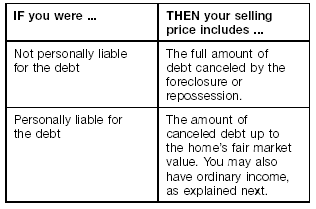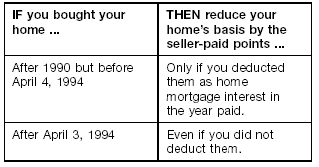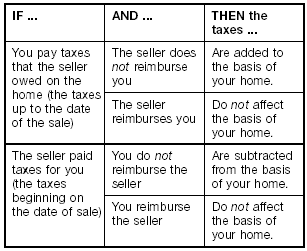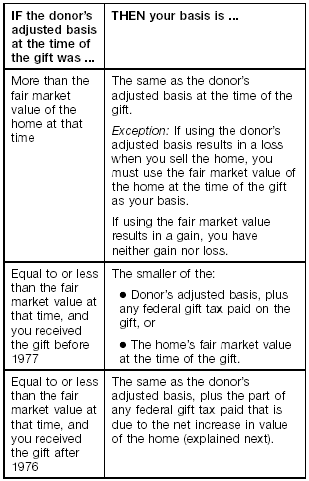2. Rules for Sales in 2001
Use the rules in this chapter if you sold your main home in 2001.
You may be able to exclude any gain from income up to a limit of $250,000 ($500,000 on a joint return in most cases). If you can exclude all of the gain, you do not need to report the sale on your tax return.
If you have gain that cannot be excluded, it is taxable. Report it on Schedule D (Form 1040).
The main topics in this chapter are:
- How to figure gain or loss,
- Basis,
- Excluding the gain,
- Ownership and use tests,
- Special situations,
- Reporting the gain, and
- Real estate and transfer taxes.
This chapter includes worksheets you can use to figure your gain (or loss) and your exclusion. Use Worksheet 1 to figure the adjusted basis of the home you sold. Use Worksheet 2 to figure the gain (or loss), the exclusion, and the taxable gain (if any) on the sale. In some situations, you may also need to use Worksheet 3 to figure a reduced maximum exclusion.
How To Figure Gain or Loss
To figure the gain or loss on the sale of your main home, you must know the selling price, the amount realized, and the adjusted basis.
Selling Price. The selling price is the total amount you receive for your home. It includes money, all notes, mortgages, or other debts assumed by the buyer as part of the sale, and the fair market value of any other property or any services you receive.
Personal property. The selling price of your home does not include amounts you received for personal property sold with your home. Personal property is property that is not a permanent part of the home. Examples are furniture, draperies, and lawn equipment. Separately stated cash you received for these items should not be shown on Form 1099-S, Proceeds from Real Estate Transactions (discussed later).
Payment by employer. You may have to sell your home because of a job transfer. If your employer pays you for a loss on the sale or for your selling expenses, do not include the payment as part of the selling price. Your employer will include it in box 1 of your Form W-2 and you will include it on line 7 of Form 1040.
Option to buy. If you grant an option to buy your home and the option is exercised, add the amount you receive for the option to the selling price of your home. If the option is not exercised, you must report the amount as ordinary income in the year the option expires. Report this amount on line 21 of Form 1040.
Form 1099-S. If you received Form 1099-S, box 2 (gross proceeds) should show the total amount you received for your home.
However, box 2 will not include the fair market value of any property other than cash or notes, or any services, you received or will receive. Instead, box 4 will be checked.
If you can exclude the entire gain, the person responsible for closing the sale generally will not have to report it on Form 1099-S. You will use sale documents and other records to figure the total amount you received for your home.
Amount realized. The amount realized is the selling price minus selling expenses.
Selling expenses. Selling expenses include commissions, advertising fees, legal fees, and loan charges paid by the seller, such as loan placement fees or points.
Adjusted basis. While you owned your home, you may have made adjustments (increases or decreases) to the basis. This adjusted basis is used to figure gain or loss on the sale of your home. For information on how to figure your home's adjusted basis, see Basis, later.
Amount of gain or loss. To figure the amount of gain or loss, compare the amount realized to the adjusted basis.
Gain on sale. If the amount realized is more than the adjusted basis, the difference is a gain and, except for any part you can exclude, generally is taxable.
Loss on sale. If the amount realized is less than the adjusted basis, the difference is a loss. A loss on the sale of your main home cannot be deducted.
Jointly owned home. If you and your spouse sell your jointly owned home and file a joint return, you figure your gain or loss as one taxpayer.
Separate returns. If you file separate returns, each of you must figure your own gain or loss according to your ownership interest in the home. Your ownership interest is determined by state law.
Joint owners not married. If you and a joint owner other than your spouse sell your jointly owned home, each of you must figure your own gain or loss according to your ownership interest in the home. Each of you applies the rules discussed in this publication on an individual basis.
Trading homes. If you trade your old home for another home, treat the trade as a sale and a purchase.
Example. You owned and lived in a home with an adjusted basis of $41,000. A real estate dealer accepted your old home as a trade-in and allowed you $50,000 toward a new home priced at $80,000. This is treated as a sale of your old home for $50,000 with a gain of $9,000 ($50,000 - $41,000).
If the dealer had allowed you $27,000 and assumed your unpaid mortgage of $23,000 on your old home, your sales price would still be $50,000 (the $27,000 trade-in allowed plus the $23,000 mortgage assumed).
Foreclosure or repossession. If your home was foreclosed on or repossessed, you have a sale.
You figure the gain or loss from the sale in generally the same way as gain or loss from any sale. But the amount of your gain or loss depends, in part, on whether you were personally liable for repaying the debt secured by the home, as shown in the following chart.

If you were not personally liable
Ordinary income. If you were personally liable for the canceled debt, you may have ordinary income in addition to any gain or loss. If the canceled debt is more than the home's fair market value, you have ordinary income equal to the difference. Report that income on line 21, Form 1040. However, the income from cancellation of debt is not taxed to you if the cancellation is intended as a gift, or if you are insolvent or bankrupt. For more information on insolvency or bankruptcy, see Publication 908, Bankruptcy Tax Guide.
Form 1099-A and Form 1099-C. Generally, you will receive Form 1099-A, Acquisition or Abandonment of Secured Property, from your lender. This form will have the information you need to determine the amount of your gain or loss and any ordinary income from cancellation of debt. If your debt is canceled, you may receive Form 1099-C, Cancellation of Debt.
More information. If part of your home is used for business or rental purposes, see Foreclosures and Repossessions in chapter 1 of Publication 544 for more information. Publication 544 has examples of how to figure gain or loss on a foreclosure or repossession.
Abandonment. If you abandon your home, you may have ordinary income. If the abandoned home secures a debt for which you are personally liable and the debt is canceled, you have ordinary income equal to the amount of canceled debt.
If the home is secured by a loan and the lender knows the home has been abandoned, the lender should send you Form 1099-A or Form 1099-C. See Foreclosure or repossession, earlier, for information about those forms. If the home is later foreclosed on or repossessed, gain or loss is figured as explained in that discussion.
Transfer to spouse. If you transfer your home to your spouse, or to your former spouse incident to your divorce, you generally have no gain or loss (unless the Exception, discussed next, applies). This is true even if you receive cash or other consideration for the home. Therefore, the rules explained in this publication do not apply.
If you owned your home jointly with your spouse and transfer your interest in the home to your spouse, or to your former spouse incident to your divorce, the same rule applies. You have no gain or loss.
A transfer of your home to your spouse, or to your former spouse incident to divorce, does not affect the basis of any new home you buy or build.
Exception. These transfer rules do not apply if your spouse or former spouse is a nonresident alien. In that case, you generally will have a gain or loss.
More information. See Property Settlements in Publication 504, Divorced or Separated Individuals, if you need more information.
Basis
You need to know your basis in your home to determine any gain or loss when you sell it. Your basis in your home is determined by how you got the home. Your basis is its cost if you bought it or built it. If you got it in some other way (inheritance, gift, etc.), its basis is either its fair market value when you got it or the adjusted basis of the person you got it from.
While you owned your home, you may have made adjustments (increases or decreases) to your home's basis. The result of these adjustments is your home's adjusted basis, which is used to figure gain or loss on the sale of your home.
To figure your adjusted basis, you can use Worksheet 1. A filled-in example of that worksheet is included in the comprehensive Illustrated Example at the end of this chapter.
Table 1 in this publication explains how to use the worksheet in certain special situations.
The main topics in this section are:
- Cost as basis,
- Basis other than cost, and
- Adjusted basis.
Cost As Basis
The cost of property is the amount you pay for it in cash, debt obligations, or other property.
Purchase. If you buy your home, your basis is its cost to you. This includes the purchase price and certain settlement or closing costs. Your purchase price includes your down payment and any debt, such as a first or second mortgage or notes you gave the seller in payment for the home.
Seller-paid points. If the person who sold you your home paid points on your loan, you may have to reduce your home's basis by the amount of the points, as shown in the following chart.

If you bought your home
If you must reduce your basis by seller-paid points and you use Worksheet 1 to figure your adjusted basis, enter the seller-paid points on line 2 of the worksheet (unless you used the seller-paid points to reduce the amount on line 1).
Settlement fees or closing costs. When you bought your home, you may have paid settlement fees or closing costs in addition to the contract price of the property. You can include in your basis the settlement fees and closing costs you paid for buying the home. You cannot include in your basis the fees and costs for getting a mortgage loan. A fee for buying the home is any fee you would have had to pay even if you paid cash for the home.
Settlement fees do not include amounts placed in escrow for the future payment of items such as taxes and insurance.
Some of the settlement fees or closing costs that you can include in your basis are:
- Abstract fees (abstract of title fees),
- Charges for installing utility services,
- Legal fees (including fees for the title search and preparing the sales contract and deed),
- Recording fees,
- Survey fees,
- Transfer taxes,
- Owner's title insurance, and
- Any amounts the seller owes that you agree to pay, such as:
- Certain real estate taxes (discussed in detail later),
- Back interest,
- Recording or mortgage fees,
- Charges for improvements or repairs, and
- Sales commissions.
Some settlement fees and closing costs not included in your basis are:
- Fire insurance premiums,
- Rent for occupancy of the house before closing,
- Charges for utilities or other services related to occupancy of the house before closing,
- Any fee or cost that you deducted as a moving expense (allowed for certain fees and costs before 1994),
- Charges connected with getting a mortgage loan, such as:
- Mortgage insurance premiums (including VA funding fees),
- Loan assumption fees,
- Cost of a credit report,
- Fee for an appraisal required by a lender, and
- Fees for refinancing a mortgage.
Real estate taxes. Real estate taxes for the year you bought your home may affect your basis, as shown in the following chart.

If you pay taxes
Construction. If you contracted to have your house built on land you own, your basis is:
- The cost of the land, plus
- The amount it cost you to complete the house, including:
- The cost of labor and materials,
- Any amounts paid to a contractor,
- Any architect's fees,
- Building permit charges,
- Utility meter and connection charges, and
- Legal fees directly connected with building the house.
Your cost includes your down payment and any debt, such as a first or second mortgage or notes you gave the seller or builder. It also includes certain settlement or closing costs. You may have to reduce your basis by points the seller paid for you. For more information, see Seller-paid points and Settlement fees or closing costs, earlier.
Built by you. If you built all or part of your house yourself, its basis is the total amount it cost you to complete it. Do not include in the cost of the house:
- The value of your own labor, or
- The value of any other labor you did not pay for.
Temporary housing. If a builder gave you temporary housing while your home was being finished, you must reduce your basis by the part of the contract price that was for the temporary housing. To figure the amount of the reduction, multiply the contract price by a fraction. The numerator is the value of the temporary housing, and the denominator is the sum of the value of the temporary housing plus the value of the home.
Cooperative apartment. Your basis in the apartment is usually the cost of your stock in the co-op housing corporation, which may include your share of a mortgage on the apartment building.
Condominium. To determine your basis in a condominium, use the same rules as for any other home.
Basis Other Than Cost
You must use a basis other than cost, such as fair market value, if you got your home as a gift, from your spouse, as an inheritance, or in a trade. If you got your home in any of these ways, see the following discussion that applies to you. If you want to figure your adjusted basis using Worksheet 1, see Table 1, later, for help.
Fair market value. Fair market value is the price at which property would change hands between a willing buyer and a willing seller, neither having to buy or sell, and both having reasonable knowledge of the relevant facts. Sales of similar property, on or about the same date, may be helpful in figuring the fair market value of the property.
Home received as gift. Use the following chart to find the basis of a home you received as a gift.

If the donor's adjusted basis
Part of federal gift tax due to net increase in value. Figure the part of the federal gift tax paid that is due to the net increase in value of the home by multiplying the total federal gift tax paid by a fraction. The numerator (top part) of the fraction is the net increase in the value of the home, and the denominator (bottom part) is the fair market value of the home. The net increase in the value of the home is its fair market value minus the donor's adjusted basis.
Home received from spouse. You may have received your home from your spouse or from your former spouse incident to your divorce.
Transfers after July 18, 1984. If you received the home after July 18, 1984, there was no gain or loss on the transfer. Your basis in this home is generally the same as your spouse's (or former spouse's) adjusted basis just before you received it. This rule applies even if you received the home in exchange for cash, the release of marital rights, the assumption of liabilities, or other consideration.
If you owned a home jointly with your spouse and your spouse transferred his or her interest in the home to you, your basis in the half interest received from your spouse is generally the same as your spouse's adjusted basis just before the transfer. This also applies if your former spouse transferred his or her interest in the home to you incident to your divorce. Your basis in the half interest you already owned does not change. Your new basis in the home is the total of these two amounts.
Transfers before July 19, 1984. If you received your home before July 19, 1984, in exchange for your release of marital rights, your basis in the home is generally its fair market value at the time you received it.
More information. For more information on property received from a spouse or former spouse, see Property Settlements in Publication 504.
Home received as inheritance. If you inherited your home, your basis is its fair market value on the date of the decedent's death or the later alternate valuation date if that date was used for federal estate tax purposes. If an estate tax return was filed, the value listed for the property generally is your basis. If a federal estate tax return did not have to be filed, your basis in the home is the same as its appraised value at the date of death for purposes of state inheritance or transmission taxes.
Surviving spouse. If you are a surviving spouse and you owned your home jointly, your basis in the home will change. The new basis for the half interest that your spouse owned will be one-half of the fair market value on the date of death (or alternate valuation date). The basis in your half will remain one-half of the adjusted basis determined previously. Your new basis is the total of these two amounts.
Example. Your jointly owned home had an adjusted basis of $50,000 on the date of your spouse's death, and the fair market value on that date was $100,000. Your new basis in the home is $75,000 ($25,000 for one-half of the adjusted basis plus $50,000 for one-half of the fair market value).
Community property. In community property states (Arizona, California, Idaho, Louisiana, Nevada, New Mexico, Texas, Washington, and Wisconsin), each spouse is usually considered to own half of the community property. When either spouse dies, the fair market value of the community property generally becomes the basis of the entire property, including the part belonging to the surviving spouse. For this to apply, at least half the value of the community property interest must be includible in the decedent's gross estate, whether or not the estate must file a return.
For more information about community property, see Publication 555, Community Property.
Home received in trade. If you acquired your home in a trade for other property, the basis of your home is generally the fair market value of the other property at the time of the trade. If you traded one home for another, you have made a sale and purchase. In that case, you may have realized a gain. See Trading homes, earlier, for an example of figuring the gain.
More information. For more information about basis, get Publication 551.
Previous | First | Next
Publication Index | 2002 Tax Help Archives | Tax Help Archives | Home
